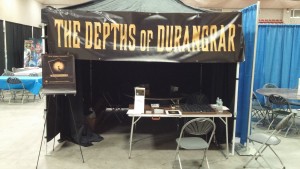This past weekend we were up at Boston FIG demoing our game. Boston FIG is a very interesting event that gives indie game developers a chance to show off their game. The way it works is that developers will send a short video to the curators at Boston FIG who will review the videos. After that, selected games will send the curators a copy of the game for review and if it passes their selection criteria, it will be chosen to be a part of the exhibit. We were very happy to be selected for the Boston FIG 2015 exhibit.
From our previous experiences at playcraftingNYC and Gen Con, just demoing how the game works in the dark wasn’t enough. In the previous events, we brought a box that had a simple viewing slot to show the game but it players couldn’t interact with the game directly as they would in normal game play. So for Boston FIG, we decided to bring a blackout canopy and invite players in to try out the game. It was a far more successful event because we were able to provide the exact experience players would have at home.
Here is out setup at the convention.
We saw many fantastic games at Boston FIG and met many creative and enthusiastic designers. Many of them gave me great advice as this was my first time convention. I truly admire and thank the generosity and friendliness of the board game community, both online and in person. I’ve learned so much in just the past year alone. Lessons and ideas that will no doubt be helpful in all aspects of life.
One very interesting concept I learned early on in game design had application again beyond just game design. I first learned about the interest curve through Jesse Schell’s book “The Art of Game Design: A book of lenses”. This blog has excellent coverage on what the interest curve is: https://marvinhawkins.wordpress.com/2011/07/12/a-word-on-interest-curves/
Looking at the interest curve, it tells me a lot on how this event was much more successful in the last two. The four defining features of the interest curve are: Initial interest, rising interest, valleys and a climax. Initial interest is what grabs a person’s attention. Rising interest is what helps a person become more engaged. Valleys allow a person to digest the information given and finally, the climax is the high point of the experience.
In my first two demos, I was able to get initial interest and as I explained the game concept further, raise interest. However, I rushed players into taking a look into the box to see the game in action without giving them a chance to really soak it in which lead to a very lackluster finish. First, many players didn’t really know what they were looking at because I had rushed them into it. Then the presentation was poor as well since it didn’t leave much room for players to actually play the game. Instead of showing the game concept well, it actually made it more confusing.
At Boston FIG, the canopy was able to grab attention in itself by being the only tent set up and large enough to grab attention from afar. Once up close, players learned that it was a game played in the dark which raise a lot of interest. I had a game setup outside the tent so players could see in great detail all the different pieces and sample it themselves. By giving the players a chance to take their time with the game pieces in the light, I gave them a break to take in all the different parts of the game. By the time they players ventured into the tent, they knew what the game was about and what to expect and were thoroughly pleased to see the game in the dark and play it as well.
In retrospect, it makes a lot of sense why the interest curve is so directly applicable. Both game design and product demonstrations serve to provide an experience. Games are an excellent way to have fun, solve problems and try new approaches. Product demonstrations are an excellent way to help people understand what a product does and if it would fulfill their needs.

COMMENTS